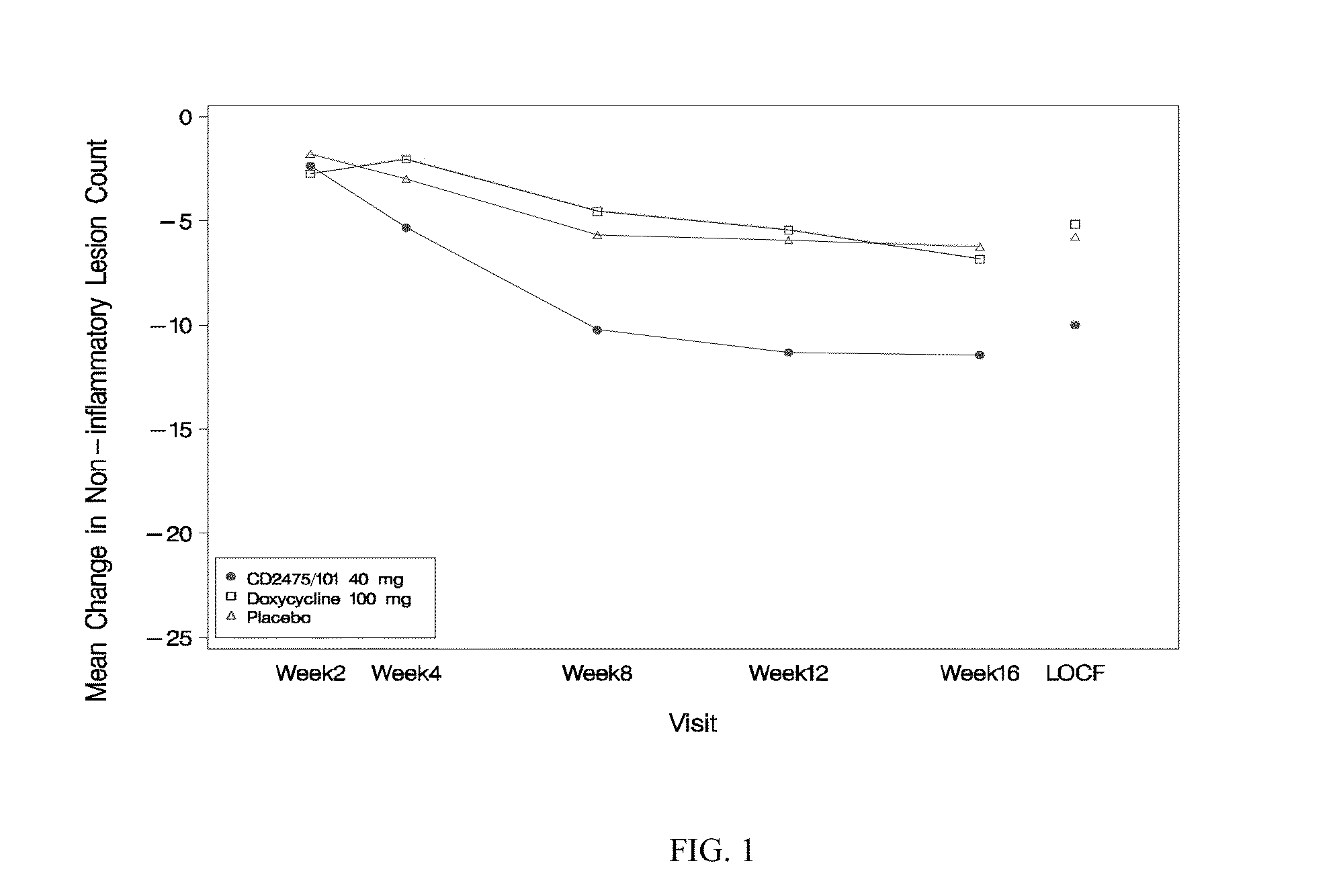Method of treating acne
a technology of acne and treatment method, applied in the field of acne treatment method, can solve the problems of increasing frequency and severity of adverse effects, reducing the availability of free fatty acids involved in inflammation, and reducing the efficacy of less than 6 months treatment, so as to achieve the effect of reducing adverse events and ensuring the effect of safety
- Summary
- Abstract
- Description
- Claims
- Application Information
AI Technical Summary
Benefits of technology
Problems solved by technology
Method used
Image
Examples
example 1
Preparation of a Tablet Composition
Wet Granulation
[0096]Doxycycline H2O (10 mg), microcrystalline cellulose (AVICEL® PH 102, 53 mg), pregelatinized starch (20 mg), and croscarmellose sodium (AC-DI-SOL®, 2 mg) were combined in a high shear weight granulator (Fielder PMA 100) and the impact of water spray parameters on wet granulates was evaluated. Variables included blade speed (low or high), spray volume, spray rate (low, medium, and high), and total spray amount. The effects of these variables were assessed by visual observation, loss on drying, and yield. It was concluded that, upon scale-up, a spray volume of about 9 liters for a 25 kg solid portion and a spray rate of about 5 to 7 liters per minute would be optimal.
[0097]In order to evaluate the impact of drying parameters on dry granulates, the wet granulates from Example 1 were placed in an O'Hara fluid bed dryer and hot air was sprayed on the wet mass. Parameters included temperatures, air volume, and LOD (loss on dryin...
example 2
Stability Studies of the Tablet Composition
[0106]The stability of sustained-release doxycycline tablets prepared as described above was evaluated by storing the tablets for three months under different temperature and relative humidity conditions and performing periodic evaluations of the tablets in terms of appearance, dissolution profile, stability, impurity profile, and moisture content. One bottle (Bottle A) of 1000 tablets was stored for three months at 25° C. and 60% RH and a second bottle of 1000 tablets (Bottle B) was stored for three months at 40° C. and 75% RH.
[0107]After one, two, and three months, tablets were removed from the bottles for analysis. The tablets were initially round and beige with a single black dot. No change in appearance was observed after one, two, or three months for the tablets in Bottle A or Bottle B at 25° C. / 60% RH and at 40° C. / 75% RH, respectively. Furthermore, there were no significant changes in stability, water content, and impurity assay res...
example 3
Preparation of a Capsule Composition
Preparation of Layered IR Pellets Containing Doxycycline Monohydrate
[0111]A dispersion of doxycycline monohydrate was prepared as follows: To 5.725 kilograms of deionized water were added 0.113 kilogram hydroxypropyl methylcellulose and 1.5 kilograms of doxycycline monohydrate, followed by moderate mixing, using a stirring paddle for 30 minutes. The drug dispersion was sprayed onto sugar seeds (30 / 35 mesh) in a 9″ Wurster Column of a GPCG-15 fluid bed processor. Until the entire dispersion was applied, the pellets were dried in the column for 5 minutes. The drug-loaded pellets were discharged from the Wurster Column and passed through a 20 mesh screen. A protective coat (e.g., OPADRY® beige) also can be applied onto the IR beads to provide color or physical protection.
Preparation of Enteric Coated Pellets Containing Doxycycline Monohydrate
[0112]The EUDRAGIT® L30D55 coating dispersion was prepared by adding 0.127 kilogram of triethyl citrate into 3...
PUM
 Login to View More
Login to View More Abstract
Description
Claims
Application Information
 Login to View More
Login to View More - R&D
- Intellectual Property
- Life Sciences
- Materials
- Tech Scout
- Unparalleled Data Quality
- Higher Quality Content
- 60% Fewer Hallucinations
Browse by: Latest US Patents, China's latest patents, Technical Efficacy Thesaurus, Application Domain, Technology Topic, Popular Technical Reports.
© 2025 PatSnap. All rights reserved.Legal|Privacy policy|Modern Slavery Act Transparency Statement|Sitemap|About US| Contact US: help@patsnap.com

